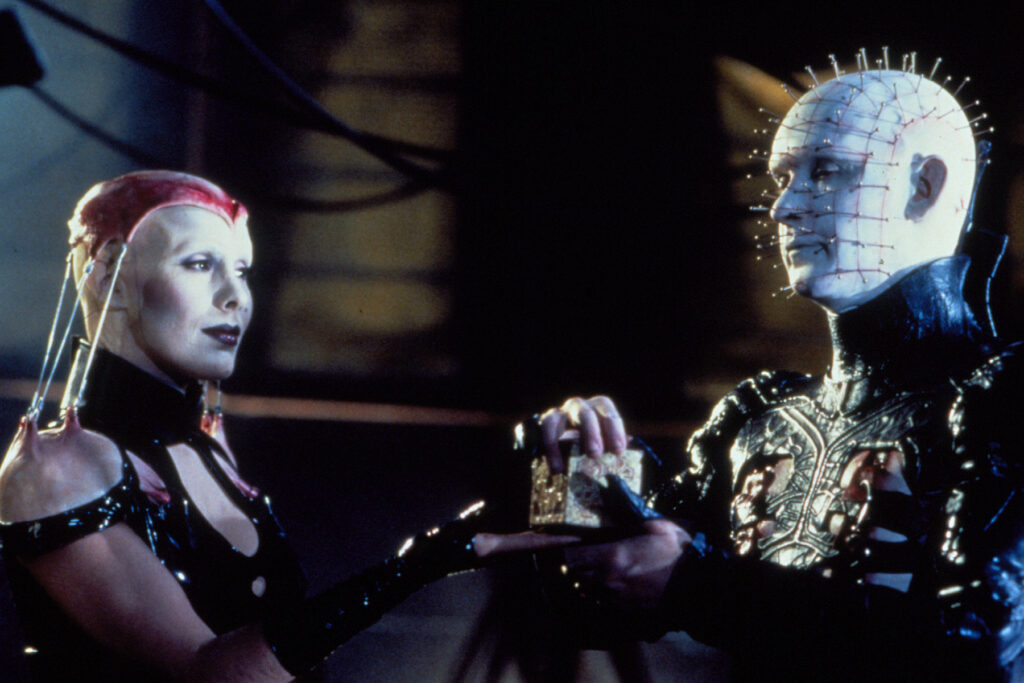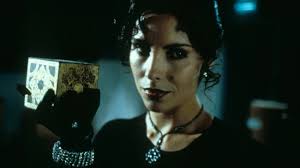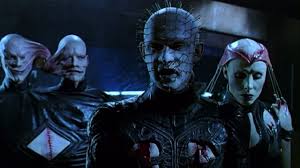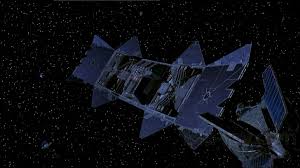
Written by: Peter Atkins
Directed by Kevin Yagher (Credited as Alan Smithee)
Hellraiser IV: Bloodline is better than you think it is.
So there.
Even in and of itself, before we get to the re-rendering on the Quartet of Torment box set, it’s just a fundamentally better film than either you remember it to be, or, if you know anything about the less than entirely straightforward pathway to its production, you expect it to be.
The first two Hellraiser films focused on a single family and their relationship to the LeMarchand puzzle box that opened a portal to Hell and let out its sadomasochistic priests, the Cenobites.
After that, there was a sense that while that particular storyline was played out, the Cenobites themselves were still very interesting and still had, to coin a phrase, “such delights to show us.”
Hellraiser III: Hell on Earth – which, for the record, is also a much better film than you remember it being – took a bold step towards advancing the Cenobites, and in particular, advancing the story of Pinhead, the “magnificently empty” Hell-priest with a headful of nails.
It brought him to contemporary Earth and had him face the need to make a new army of Cenobites to follow him, and open the gates of Hell permanently – advancing him from an interesting plot-device to a full-blown antagonist with a motivation and a plan.
It also dealt with the notion that the Cenobites, including Pinhead, had once been human themselves, and that, especially in his case, there was a duality at work between the human and the demon. In fact, the resolution of the movie involved a moment when the human was briefly stronger, able to give advice to the first scream queen in the series who actively showed her intellect, Terry Farrell’s Joey Summerskill.
The Architecture of Hell
At the end of that third movie, Joey buries the LaMarchand box in the concrete footings of a new skyscraper, with the intention that that action will put the box out of harm’s way forever. The denouement to which is that the building, when it’s finally built, is shown to be covered throughout by the intricate markings of the box. It becomes the LeMarchand box-as-building – a significantly larger portal than the handheld puzzle box had ever been.
That left the makers of the fourth movie with a handful of potential directions in which to go. If there’s an issue with Hellraiser IV: Bloodline, it’s that they try to go in all of the potential directions at once.
On the one hand, there’s always been one central core to the Hellraiser story – the LeMarchand puzzle box. Would it not be great fun to take viewers back to the unseen beginning of the box, to show how something that is ostensibly a work of puzzle-making art became a portal to the Hell dimensions?
Yes, it would – let’s do that.
On the other hand, we left the third movie with the visual of the LeMarchand box “infecting” the architecture of a city skyscraper. Wouldn’t it be cool to pick up on that storyline – Cenobites as architects, bringing their portal to a much grander in our relatively contemporary time?
Yes, it would – let’s do that too.
And finally, if there was to be ongoing long-term scope for the Cenobites beyond these first four movies, it was crucial that they had a broader extended universe than they’d had so far – so how about Cenobites…in space?!

Sounds fun – let’s do that!
Sex and Punishment – War of the Cenobites
The resulting movie makes a credible fist of being all things to all people, while also adding in a plot dynamic that takes the story back to its initial outing. When we first see Frank Cotton trying to open the box in the original Hellraiser, he’s not expecting the sadomasochists from Hell by any stretch of the imagination. He’s expecting nubile, obedient women to serve his every depraved need – the idea being that the box can bring soft seductions as well as the more hardcore S&M delights of Pinhead and his order.
The dichotomy between Hell as a seductive power and Hell as a place of eternal punishment is played out in Bloodline, with the invention of a new princess of Hell, Angelique (Valentina Vargas), to contrast against Doug Bradley’s by-then signature villain, Pinhead, and his harsher approach.
Add to that the “bloodline” of the title – three points in the LeMarchand family history – and you’re already starting to get a movie that’s very crowded in terms of its plot. That, by necessity, will mean each strand of the storytelling has a lot to do in relatively little time.
An Unholy Trinity
You could fairly easily argue that each of the strands of Hellraiser IV: Bloodline could be a movie in its own right, and – given enough budget and time – you could make a pretty good fist of delivering a three-movie Bloodline sequence to balance up everything that’s come before it.
That…didn’t happen here. What Hellraiser IV: Bloodline tries bravely to do, bless it, is show that potential three-movie sequence in the space and time of one movie.
Doomed. Doomed to fail, naturally, because each of the three settings brings enough potential story for a full movie, and the dichotomy between Hell the seducer and Hell the punisher has enough inherent philosophical power to travel the three-movie distance, which means it feels distinctly cramped and crushed trying to travel that amount of distance in the space of just one film.
Also, if we’re being brutally honest, having a single actor (Bruce Ramsay) play all three members of the LeMarchand bloodline in the past, present and future has a feeling of cheapness that was probably best avoided.
Cenobites Innnnn Spaaaaaaace!
We start with Cenobites in space – a bold, if not entirely successful strategy – where in 2127, Dr Paul Merchant, descendant of the original LeMarchand, is aboard a space station he designed, summoning Pinhead and very much about to be arrested for his dubious use of a space station(!). The rest of the story is supposedly told by him to officer Rimmer (Christine Harnos), who’s technically there to arrest him, revealing his family’s history with Hell. (Yes, Rimmer. In space. Eight years into Red Dwarf’s TV success. It’s not a huge point, but it does stop some viewers taking her seriously).
The historical instalment of the Bloodlines tale gives us a brief – some would argue a criminally brief – exploration of how a French toymaker can come to create a portal to Hell. It’s rich, it’s simple, it gives Hell-princess Angelique the body of a French sex worker and it, allegedly, curses the bloodline of LeMarchand because of the toymaker’s involvement in the creation of the box. Which sounds like nonsense, but is fairly in-keeping with the fantasy biophysics of creator Clive Barker’s take on Hell.
Hell’s Architect
Cut to the “contemporary” story of architect and building designer John Merchant – the force behind the skyscraper with all the Lament Configuration sigils on it. That section tries to do waaaay too much heavy lifting. It’s supposed to be not only a scene of humanity finding a way to fight back against the Cenobite threat, but also to echo the first Hellraiser in terms of the psycho-sexual threat – the ordinary life of marriage and kids versus the dark seductions of Hell – and to set the scene for space-era Paul Merchant to bring the whole Pinhead arc technically to a close.
It’s sadly the least effective of the three sections of the film. We barely care about John Merchant’s nightmares, or his plans, or his potential infidelities with Angelique. His wife Bobbi (Kim Myers), supposed originally to be a counterpoint to Andrew Robinson’s Larry Cotton in the first movie, barely makes an impression.
Yes, it has the most to say between the different approaches of Hell, and when Angelique appears to be getting the job done, there’s a certain classic villainy about the fact that Pinhead simply gets impatient with the softer approach and starts throwing both his weight and his chains about, bringing Merchant (and the whole mid-section of the movie) to a premature end.
That feels more like a budget and timing decision writ large on screen than it does a storytelling cut for briskness, and it leaves that mid-section feeling, if anything, even more truncated than the visually lush but underdeveloped toymaker section.
A Base Under Siege
And so finally we end up back where we started – with space-age Cenobites, including Angelique (who is somewhat perfunctorily added to Pinhead’s crew), a nicely gruesome pair of space-age brothers who undergo transformation into Cenobites in a nod to the third movie, and a kind of Chatterer-Dog Cenobite pet (the origins of which are not shown in the film, but which it could be argued are explained in the eventual second Hellraiser book by Clive Barker, The Scarlet Gospels).
And similarly, we’re back where we started in terms of the evolution down the bloodline of a plan to trap – and potentially eradicate – the Cenobites forever. While in the contemporary storyline, the idea of a Lament Configuration building is to create a much bigger portal to allow the demons through into our world, by the time we get to space-Merchant, that idea has evolved into an inversion, a big McGuffin that can ultimately bring an end to the Cenobites and free the LeMarchand bloodline from its curse.
There is, in fact, nothing wrong with any of this that more time, more money, and just potentially some slightly different approaches to rendering three generations of the LeMarchand family on screen couldn’t fix.
The “What-Could-have-Been” Factor
And it’s entirely possible to rehearse the film’s troubled history in another article, but based entirely on what made it to the screen, what you’re left with is an ambitious movie that roots itself in the history of the mythos and extends it significantly.
None of that is a bad thing. It’s just that as you watch it, nothing seems to have the space and time it needs to breathe, so you get that sense of a film with the potential to be a three-movie sequence, squashed down and distorted like a duck in a press, to give you ultimately just the idea of what that longer sequence could have delivered.
Bottom line, Hellraiser IV: Bloodline is a pretty good Hellraiser movie, and as with all the iterations in the Quartet of Terror box set, it’s never looked or sounded better than it does here.
The only real issue with it is that by being “only” a pretty good Hellraiser movie, it inevitably exposes the significantly better three Hellraiser movies it could have been.






Be the first to comment on "Hellraiser: Quartet of Torment box set: Hellraiser IV – Bloodline"